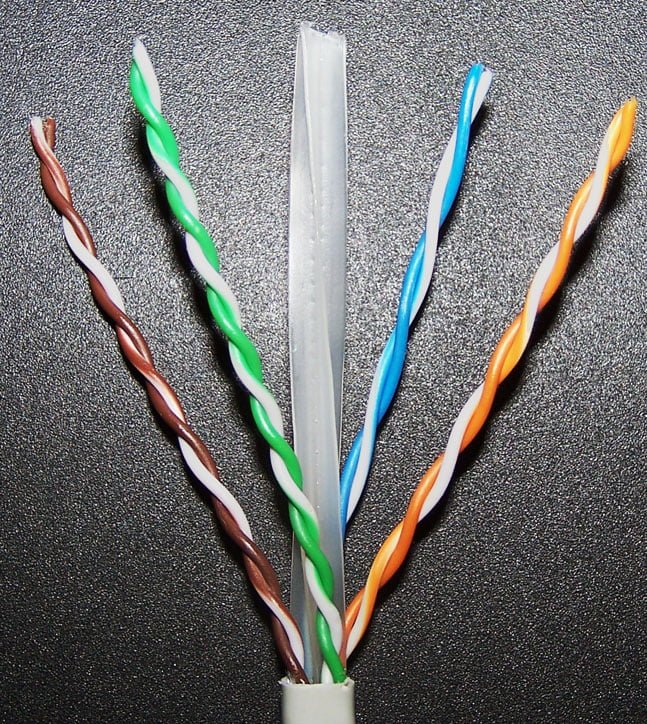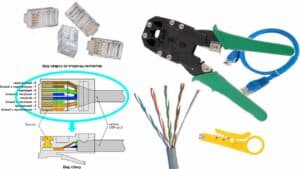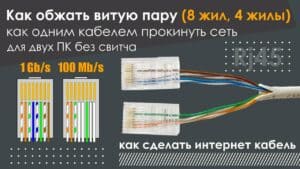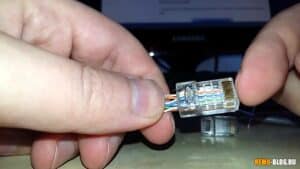- Basic principles of twisted pair cable operation
- The influence of twisted pair on the quality of data transmission
- Types of twisted pairs and their features
- UTP, STP, FTP: what types of twisted pairs are there and how do they differ?
- How to choose the right twisted pair for a specific network?
- The use of twisted pair in modern network technologies
- How is twisted pair cable used in Ethernet networks?
Basic principles of twisted pair cable operation
Twisted pair is a cable made up of two or more conductors twisted together in a spiral shape. One conductor is called 'positive' and the other is 'negative'. This type of cable is widely used in networking technologies for data transmission. The main operating principle of twisted pair is to reduce interference and noise that occurs during data transmission. Twisting the conductors in a spiral shape helps reduce electromagnetic interference and protect the signal from external influences. In addition, twisted pair has a high data transfer rate and can transmit signals over long distances without loss of quality. To achieve this, the cable uses various technologies such as noise reduction and signal amplification. Twisted pair is used in various networking technologies such as Ethernet, Token Ring, FDDI and others. It is also widely used in telephone lines and data networks. In conclusion, twisted pair is one of the most important types of cables in networking technologies. Its main operating principles are to reduce interference and noise, high data transfer rate and the ability to transmit signals over long distances without loss of quality. A twisted pair is a cable made up of two or more wires twisted together. It is used to transmit data in computer networks, telephone lines, and other communication systems.
Materials used in the manufacture of twisted pair cable include copper, aluminum and other metals. The wires can be insulated with plastic or rubber and twisted together in a specific pattern to reduce interference and improve data transmission quality.
There are several types of twisted pair, including unshielded twisted pair (UTP), shielded twisted pair (STP), and foiled twisted pair (FTP). Each type has its own advantages and is used depending on the specific needs of the network.
Twisted pair is one of the most common types of cables used in networking technologies. It provides high data transfer rates and good interference protection. When installed and used correctly, twisted pair cable can be a reliable and effective solution for your networking needs.
The influence of twisted pair on the quality of data transmission
A twisted pair is a cable made up of two or more conductors twisted around each other in a special pattern. This cable is used to transmit data in computer networks and telecommunications systems.
Twisted pair cable has a number of advantages, including resistance to interference and the ability to transmit data over long distances. However, the quality of data transmission can significantly depend on the quality of the cable itself, as well as on operating conditions.
For example, if the cable does not meet the required standards, it may result in data loss or signal distortion. Also, if the cable runs near sources of electromagnetic interference, this may reduce the quality of data transmission.
Therefore, when choosing a cable and installing it, it is necessary to take into account all factors that may affect the quality of data transmission. It is also important to monitor the condition of the cable and regularly check it for damage or defects.
The use of twisted pair in network technologies is one of the most common methods of data transmission. The correct choice of cable and its operation can significantly improve the quality of data transmission and ensure stable network operation.
Types of twisted pairs and their features
Twisted pair is a cable consisting of two or more conductors that are twisted around each other to reduce electromagnetic interference. There are different types of twisted pair cables that can be used in network technologies:
- UTP (Unshielded Twisted Pair) – twisted pair without shielding. Such a cable has low cost, but also higher sensitivity to interference;
- STP (Shielded Twisted Pair) – twisted pair with shielding. Such a cable has a higher cost, but also higher immunity to interference;
- FTP (Foil Twisted Pair) – twisted pair with foil shield. Such a cable has high immunity to interference, but also higher cost;
- STP/FTP (Shielded and Foil Twisted Pair) – twisted pair with shielding and foil screen. This cable has the highest immunity to interference, but also the highest cost.
The choice of a specific type of twisted pair depends on the signal quality requirements and the project budget.
UTP, STP, FTP: what types of twisted pairs are there and how do they differ?
A twisted pair is a cable made up of two conductors twisted together. It is used to transmit data in computer networks. There are several types of twisted pairs: UTP (Unshielded Twisted Pair), STP (Shielded Twisted Pair), and FTP (Foiled Twisted Pair).
UTP is the most common type of twisted pair used in most modern computer networks. It consists of four pairs of conductors that are not protected from electromagnetic interference. UTP cables come in different categories, which determine the speed of data transfer.
STP is a twisted pair that has protection against electromagnetic interference. It is used in networks where a high degree of protection against interference is very important. STP cables also come in different categories.
FTP is a twisted pair that has interference protection in the form of foil wrapped around the conductors. It provides more interference protection than UTP, but less than STP.
Depending on the quality and data transfer speed requirements, you can select the appropriate type of twisted pair for your network.
How to choose the right twisted pair for a specific network?
Selecting the right twisted pair for your network is a very important step when installing network devices and equipment. Choosing the right twisted pair will help ensure efficient data transfer and reliable operation of the network as a whole.
When choosing a twisted pair cable for your network, there are several factors to consider:
1. Data transfer speed.
Depending on the data transfer rate, it is necessary to select the appropriate category of twisted pair. For example, for speeds up to 100 Mbps, it is recommended to use category 5e, and for speeds up to 10 Gbps, category 6a.
2. Cable length.
The length of the cable also affects the choice of twisted pair. For short distances, you can use category 5e cable, and for long distances, category 6 or 6a.
3. Noise and interference.
If there is a lot of noise and interference in the network, then you need to choose a twisted pair cable with a higher degree of protection. For example, Category 7 or 7a cable is better protected from noise and interference than Category 6 cable.
4. Budget.
Depending on your budget, you must select the appropriate category of twisted pair cable. The higher the cable category, the higher its cost.
In general, when choosing a twisted pair cable for your network, you need to consider data speed, cable length, noise and interference, and budget. Only a carefully thought-out choice will help ensure efficient network operation and data transfer.
The use of twisted pair in modern network technologies
Twisted pair is a cable consisting of several pairs of wires that are intertwined with each other. This design provides protection against electromagnetic interference and allows data to be transmitted over long distances without loss.
In modern network technologies, twisted pair cables are used to transmit data in local area networks (LANs). It is the main means of communication between computers, routers and other network devices.
There are several standards for twisted pair that define its characteristics, such as data transfer speed and connection range. The most common standards are Cat5, Cat5e, Cat6 and Cat6a.
Cat5 and Cat5e are standards that are used to transmit data at speeds of up to 1 Gbit/s over distances of up to 100 meters. Cat6 and Cat6a are more modern standards that allow data transmission at speeds of up to 10 Gbit/s over distances of up to 55 meters and 100 meters, respectively.
In addition, twisted pair cable can be used to connect CCTV cameras, telephones and other devices that require data transmission via cable.
In general, twisted pair cable is a reliable and efficient way to transmit data in modern network technologies. It allows you to transfer large amounts of data over long distances without loss and protects against electromagnetic interference.
How is twisted pair cable used in Ethernet networks?
Twisted pair cable is one of the most common types of cabling used in Ethernet networks. This type of cable consists of a pair of conductors that are woven together and protected from external influences.
Twisted pair cable is used for data transmission in Ethernet networks, where it plays a key role in ensuring high-speed information transfer. In addition, twisted pair cable is also used in other network technologies such as telephone lines and video surveillance networks.
In Ethernet networks, twisted pair cables are typically used to connect computers and other devices on the network. The cable connects to network cards on computers and equipment such as routers and switches and enables fast data transfer between them.
Twisted pair cable can also be used to connect computers to longer-distance devices such as modems or Internet gateways. In this case, the cable may be longer and is usually used in combination with other technologies such as DSL or cable Internet.
Overall, twisted pair is a reliable and efficient way to connect devices in Ethernet networks. It provides fast data transfer and protection from external influences, making it an ideal choice for most networking applications. Twisted pair is a cable consisting of two conductors that are twisted around each other. This cable is widely used in networking technologies such as Ethernet and telephone lines.
One of the main reasons for using twisted pair is its ability to increase data transfer speeds. When a signal is transmitted through a cable, electrical interference occurs which can reduce the quality of the signal. Twisted pair reduces this interference by twisting the wires in the cable around each other. This allows for faster data transfer speeds and better signal quality.
Twisted pair also has other benefits, such as added protection against radio frequency interference and the ability to transmit data over long distances without loss of quality. Twisted pair cable can also be used to transmit video and audio signals.
In general, using twisted pair is one of the most effective ways to increase the data transfer rate in network technologies. The cable is reliable and durable, and it can be used in various areas where a fast and stable connection is needed.
Read further:






